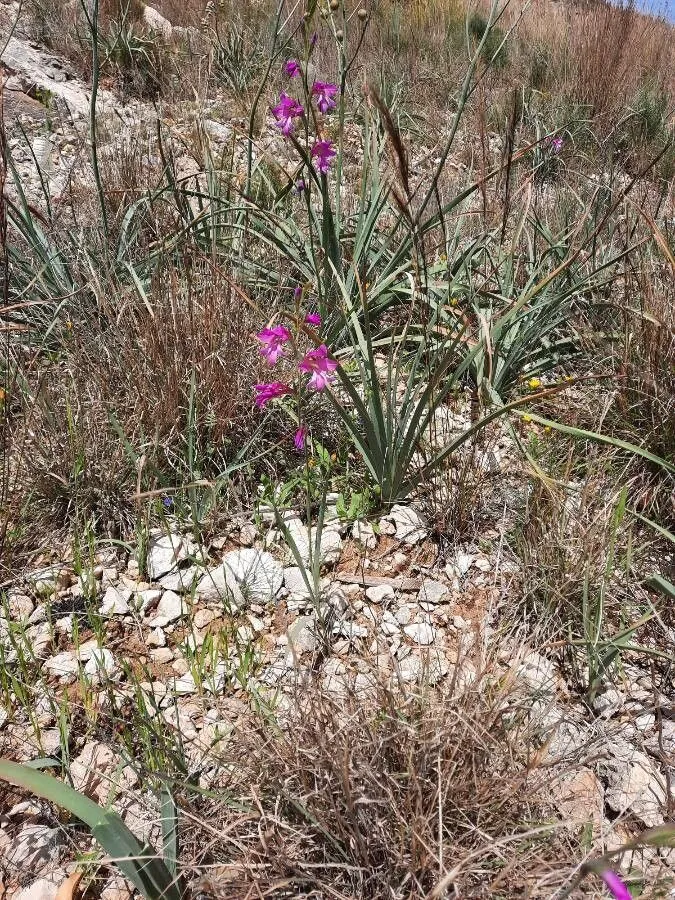
Author: W.D.J.Koch
Bibliography: Syn. fl. germ. helv. 699. 1837
Year: 1837
Status: accepted
Rank: species
Genus: Gladiolus
Vegetable: False
Observations: S. Europe to W. Türkiye
Wild gladiolus, a picturesque and captivating plant, belongs to the family Iridaceae. Known scientifically as Gladiolus illyricus, this species graces the landscapes of southern Europe extending eastward to western Türkiye, bringing a splash of vibrant color to its natural habitats.
First described in detail in the early 19th century by the botanist W.D.J.Koch, Gladiolus illyricus has been a subject of fascination and admiration for many plant enthusiasts and botanists. Its historical significance and botanical features are well-documented in sources such as the Syn. fl. germ. helv. from the year 1837, which offers an in-depth look at this delicate yet resilient species.
Typically found thriving in sunny meadows and along the fringes of woodlands, the wild gladiolus exhibits slender, upright stems that can reach an impressive height, adorned with narrow, lance-shaped leaves. The crowning glory of this plant, however, is its charming floral spikes, which bear a succession of vibrant, funnel-shaped flowers. These blooms are predominantly shades of pink or magenta, each one a tiny masterpiece of natural design, attracting various pollinators and adding to the ecosystem’s biodiversity.
The wild gladiolus’s robust adaptability allows it to flourish in a range of soil conditions, although it shows a marked preference for well-drained, sandy, or rocky substrates. This resilience combines with its aesthetic appeal to make it a beloved subject in horticultural circles, admired not only for its beauty but also for its relative ease of cultivation.
Interestingly, the wild gladiolus holds cultural and symbolic significance in various regions where it naturally occurs. Often associated with strength and moral integrity due to its sturdy stem and striking flowers, it serves as a reminder of nature’s enduring elegance and resilience.
In essence, Gladiolus illyricus is more than just a wildflower; it is a testament to the rich botanical heritage of southern Europe and western Türkiye. Its presence in the wild and in gardens alike underscores the diversity and splendor of the natural world, making it a cherished subject for botanical study and aesthetic appreciation alike.
Deu: illyrische siegwurz
Swe: mörkröd sabellilja
Eng: wild gladiolus
Cym: blodau’r cleddyf, blodyn y cleddyf
Lat: gladiolus
En: Wild gladiolus
Fr: Glaïeul douteux, Glaïeul commun, Glaïeul d’Illyrie
De: Illyrische Siegwurz
La: Gladiolus
Pt: Espadana-dos-montes
Sv: Mörkröd sabellilja
Cy: Blodau’r Cleddyf, Blodyn y Cleddyf
Taken Mar 19, 2021 by juliachorabik (cc-by-sa)
Taken Apr 9, 2022 by michael gödde (cc-by-sa)
Taken Mar 20, 2020 by Nelly Heise (cc-by-sa)
Taken Feb 27, 2022 by Wilma Joosten-Gerrits (cc-by-sa)
Taken Apr 1, 2018 by Corinna Vogt-Hell (cc-by-sa)
Taken Jun 20, 2020 by Bojan Runtic (cc-by-sa)
Taken Apr 11, 2021 by Miguel A. C. (cc-by-sa)
Taken May 28, 2022 by manuseitz (cc-by-sa)
Taken Jun 30, 2021 by Uxeli (cc-by-sa)
Taken Apr 9, 2022 by michael gödde (cc-by-sa)
Taken Jul 10, 2020 by Krampl Tomáš (cc-by-sa)
Taken May 5, 2022 by Llandrich anna (cc-by-sa)
Taken May 28, 2022 by manuseitz (cc-by-sa)
Taken Mar 27, 2021 by Santoyo Javier (cc-by-sa)
Taken Jun 1, 2019 by bas yves (cc-by-sa)
Taken Apr 8, 2021 by amnogues (cc-by-sa)
Taken May 5, 2020 by Gaifém Luís (cc-by-sa)
Taken Apr 11, 2021 by Miguel A. C. (cc-by-sa)
Taken Jun 30, 2021 by Uxeli (cc-by-sa)
Taken Apr 26, 2016 by Tela Botanica − Liliane ROUBAUDI (cc-by-sa)
Taken Apr 26, 2016 by Tela Botanica − Liliane ROUBAUDI (cc-by-sa)
© copyright of the Board of Trustees of the Royal Botanic Gardens, Kew.
© copyright of the Board of Trustees of the Royal Botanic Gardens, Kew.
Taken Apr 17, 2021 by Guy MOLL (cc-by-sa)
Ph maximum: 7.5
Ph minimum: 7.0
Light: 8
Atmospheric humidity: 8
Bloom months: [‘apr’, ‘may’, ‘jun’, ‘jul’]
Soil nutriments: 3
Family: Myrtaceae Author: (F.Muell.) K.D.Hill & L.A.S.Johnson Bibliography: Telopea 6: 402 (1995) Year: 1995 Status:…
Family: Rubiaceae Author: Pierre ex A.Froehner Bibliography: Notizbl. Bot. Gart. Berlin-Dahlem 1: 237 (1897) Year:…
Family: Sapindaceae Author: Koidz. Bibliography: J. Coll. Sci. Imp. Univ. Tokyo 32(1): 38 (1911) Year:…
Family: Asteraceae Author: A.Gray Bibliography: Pacif. Railr. Rep.: 107 (1857) Year: 1857 Status: accepted Rank:…
Family: Fabaceae Author: Medik. Bibliography: Vorles. Churpfälz. Phys.-Ökon. Ges. 2: 398 (1787) Year: 1787 Status:…
Family: Aspleniaceae Author: (Cav.) Alston Bibliography: Bull. Misc. Inform. Kew 1932: 309 (1932) Year: 1932…